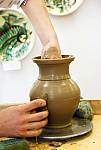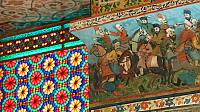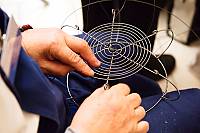
Tradition of Kosiv painted ceramics
inscribed,Tradition of Kosiv painted ceramics The tradition of Kosiv painted ceramics – which include dishes, ceremonial items, toys and tiles – arose in the 18th century, reaching its golden age in the mid-19th century. The products are made using local grey clay, watered with a white clay of creamy texture; when dried, they are painted using... Ukraine
inscribed,Artisanal talavera of Puebla and Tlaxcala (Mexico) and ceramics of Talavera de la Reina and El Puente del Arzobispo (Spain) making process The processes of making the artisanal talavera of Puebla and Tlaxcala (Mexico) and ceramics of Talavera de la Reina and El Puente del Arzobispo (Spain) are identified with two communities in both Mexic... Spain
, Mexico
Craftsmanship of Horezu ceramics
Inscribed,Craftsmanship of Horezu ceramics Horezu ceramics are a unique traditional craft. Handmade in the northern part of Vâlcea County, Romania, they reflect generations of knowledge and craftsmanship. Men and women generally divide the fabrication processes. Men select and extract the earth, which is then cleaned, cut, watered, kneaded, trampl... Romania
The Committee Takes note that Romania has nominated craftsmanship of Horezu ceramics for inscription on the Representative List of the Intangible Cultural Heritage of Humanity: Horezu ceramics are a unique traditional craft. Handmade in the northern part of Vâlcea County, Romania, they reflect generations of knowledge and craftsmanship. Men and...7 December 2012
Paris
National inventory revival of the traditional ceramics
National inventory revival of the traditional ceramics,Uzbek potters used special techniques for producing the famous bluecoloured glaze to decorate vessels and tiles. Many sacred monuments in the city of Samarkand, the ancient centre of this art, memorialize this century-old tradition. The project aimed to revive the technique of producing the t...Benefitting country(ies) : Uzbekistan
1 January 2003 - 1 July 2008
The Committee, Takes note that Ukraine has nominated Tradition of Kosiv painted ceramics (No. 01456) for inscription on the Representative List of the Intangible Cultural Heritage of Humanity: The tradition of Kosiv painted ceramics – which include dishes, ceremonial items, toys and tiles – arose in the 18th century, reaching its golden age...14 December 2019
Bogotá
es note that Mexico and Spain have nominated Artisanal talavera of Puebla and Tlaxcala (Mexico) and ceramics of Talavera de la Reina and El Puente del Arzobispo (Spain) making process (No. 01462) for inscription on the Representative List of the Intangible Cultural Heritage of Humanity: The processes of making the artisanal talavera of Puebla and...14 December 2019
Bogotá
ontributes to the enrichment of cultural diversity and human creativity. The production and sale of ceramics are also a source of livelihood and a key part of the social and economic life of the communities concerned.... Uzbekistan
involves the design and creation of small paintings on books, papier-mâché, rugs, textiles, walls, ceramics and other items using raw materials such as gold, silver and various organic substances. Historically, the miniature was exemplified by book painting in which the text was supported visually, but the element has evolved and can also be obs... Azerbaijan
, Türkiye
Drotárstvo, wire craft and art
to this day. Initially, wire art and craft was a complementary task performed by labourers to repair ceramics and cookware and produce and sell simple wire tools. In the 19th century, the practice became an autonomous craft, and since the 20th century, wire craftspeople have used wire to produce tools for daily use and art objects. As in the past,... Slovakia









